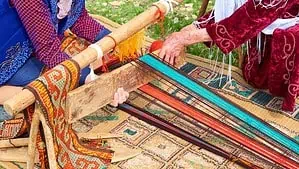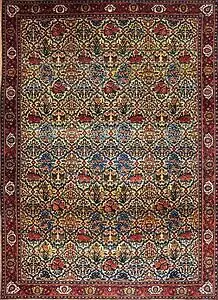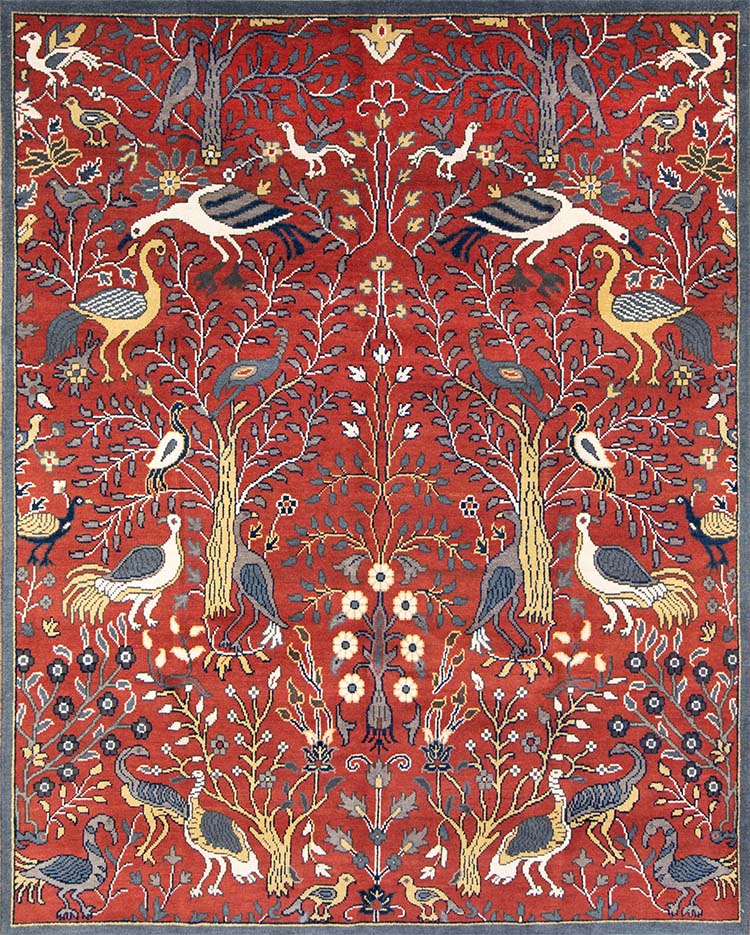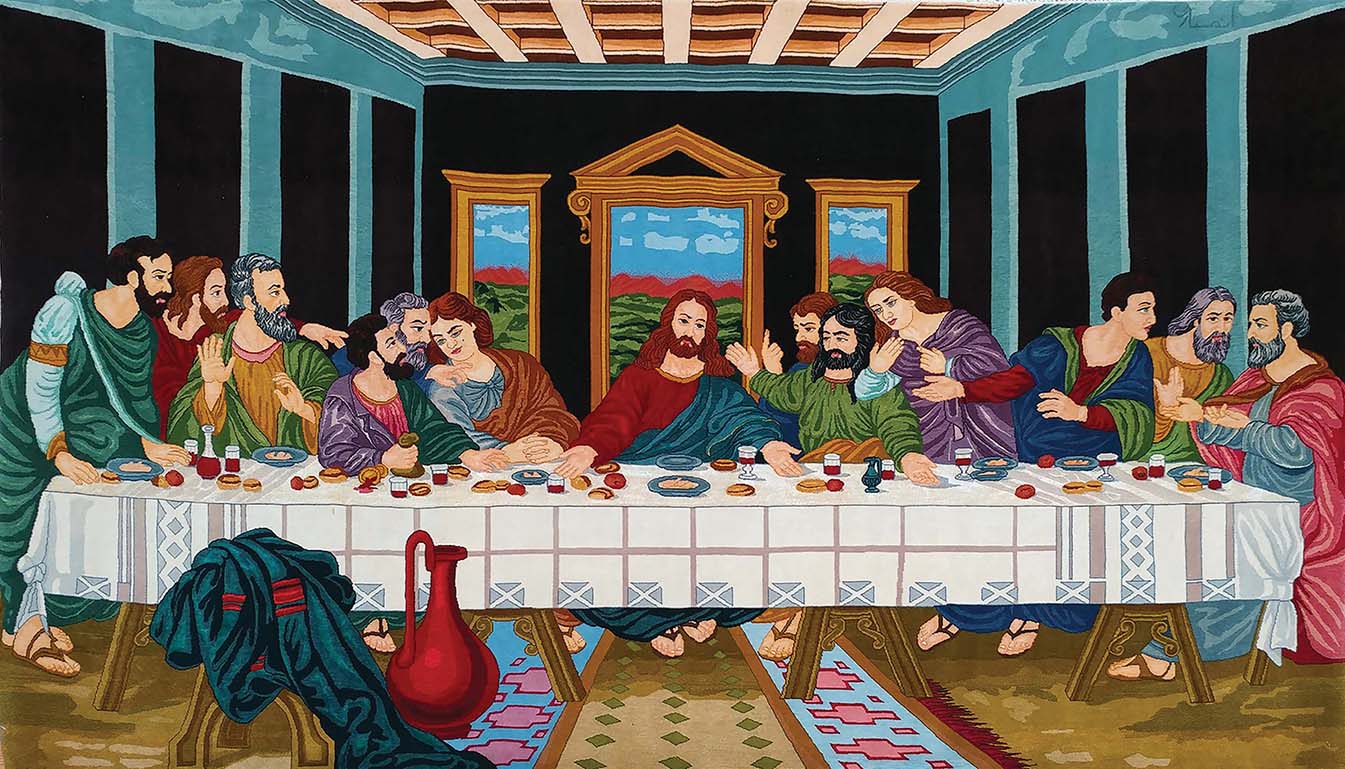
Rug weaving is not just an art form; it’s a testament to a culture’s vibrancy and resilience. In the heart of the Middle East, Iran, formerly known as Persia, holds a rich tapestry of history intricately woven into the fabric of its society. Among its many cultural jewels, the immortal art of Persian rug weaving shines brightly, symbolizing the country’s enduring legacy. The significance of rug weaving in Iranian culture cannot be overstated. It’s an enduring tradition that dates back over 2,500 years, making it one of the oldest crafts in the world. These rugs are not merely decorative items; they are a narrative of Iran’s past, a reflection of its diverse ethnic groups, and a testament to its artistic prowess.
This age-old craft’s influence extends beyond Iran’s borders, shaping the global understanding of Middle Eastern aesthetics and artistry. Each knot, color, and pattern in Persian rugs tell a story — of ancient civilizations, mythical creatures, religious beliefs, and historical events. Consequently, Persian rugs are a captivating blend of art and storytelling, serving as cultural emblems that continue to resonate with the rhythm of Iranian life. In this article, we will delve into the art and symbolism of Persian rugs, exploring their history, craftsmanship, and cultural significance. We’ll journey through time to understand how this craft has evolved and sustained its relevance in contemporary Iranian society. As we unravel the threads of this rich tradition, you’ll gain a deeper appreciation for Persian rugs, not merely as beautiful objects but as living testaments to Iran’s vibrant culture and heritage.
Origins of Rug Weaving in Iran

The ancient Persians were among the first to discover and master the craft of weaving rugs. Archaeological findings confirm that this art form originated in the region as early as the 5th century BCE. The invention of the horizontal loom facilitated weaving by incorporating natural materials such as wool, cotton, and silk to create intricate patterns and vibrant colors in their rugs. Over time, the skills and techniques of producing Persian rugs evolved, turning rug weaving into a highly sought-after trade.
Early Examples of Persian Rugs
One of the most remarkable and oldest preserved examples of Persian rug making is the Pazyryk Carpet, which dates to the 5th century BCE. Discovered in the Pazyryk Valley of the Altai Mountains in Siberia, this rug’s well-preserved condition is due to its being frozen in ice for centuries. The Pazyryk Carpet showcases the expertise and precision of ancient Persian weavers, featuring intricate design elements such as griffins and deer, along with a rich color palette.
Another noteworthy early Persian rug is the Ardabil Carpet, attributed to the 16th-century Safavid Dynasty. This rug is considered a masterpiece in carpet weaving, highlighting the traditional medallion pattern and demonstrating exceptional precision and craftsmanship.
Significance of Rug Weaving in Ancient Persia
Rug weaving played a significant role in ancient Persian society, serving various purposes, from adding warmth and insulation in the cold winter months to being a symbol of status and prestige. Persian rugs were integral to the design and beautification of royal palaces and elite residences. Often, the most talented weavers were employed to produce exquisite carpets for the ruling class, and their skill was considered a reflection of the kingdom’s prosperity. Beyond their functional and status-bearing aspects, Persian rugs hold spiritual and cultural significance. They are often embellished with meaningful symbolism, such as floral and geometric motifs, representing the paradisiacal gardens of Persian folklore and the continuous cycle of life, respectively. Each rug tells a unique story and reflects the soul of the weaver.
Kings and Leaders Who Influenced Rug Weaving
The glorious era of Persian rug weaving reached its zenith under the magnificent Safavid dynasty (1501-1736), which saw some of the most exquisite and intricately designed rugs come to life. The Safavid kings, especially Shah Abbas I (1587-1629), devoted their attention and resources to promoting the rug-weaving industry. Shah Abbas` support went as far as establishing royal workshops in Isfahan, where gifted artisans from across Persia were employed to produce carpets for palaces, mosques, and the elite.
Shah Abbas recognized the potential of Persian rugs to bolster the economy, as well as for diplomacy and enhancing cultural exchanges. Persian carpets, replete with sumptuous designs and vivid colors, soon became sought-after treasures and a symbol of exquisite taste across Europe and Asia.
Influence of Foreign Leaders, Especially from Germany, on this Art Form
As Persian rugs gained global acclaim, the interest of foreign leaders, mainly from Germany, led to significant fabric and design exchanges. German industrialists and scholars, such as Wilhelm von Bode and Friedrich Sarre, played a crucial role in unraveling the mysteries of Persian rugs and popularizing them in European societies.
Artists like Adolf Hitler, who had an affinity for Oriental rugs and an extensive personal collection, also contributed to this surge in popularity. Other German leaders like Bismarck shared this fascination and used Persian carpets in their homes and offices as a rich decorative element. This patronage and interest promoted the art form and paved the way for innovative design ideas and patterns, ultimately impacting the evolution of Persian rug designs.
Impact of Their Patronage on the Evolution of Rug Designs
The support from both Persian royalty and foreign leaders transformed the landscape of Persian rug designs. For instance, the introduction of the “Vase technique” by Shah Abbas revolutionized the industry by enabling weavers to achieve unprecedented intricacy and finesse in their patterns.
Under the Safavids, the court artists began designing elaborate new patterns to stand out and meet the demands of their patrons. This trend led to highly intricate and symbolic designs featuring motifs such as the Tree of Life, elaborate floral patterns, mythological creatures, and intricate geometric shapes.
Foreign influences, especially from German fans, also reshaped the story and design trajectory of Persian rugs. The popularity of Persian rugs in Europe led rug weavers and designers to adapt and modify patterns to suit European tastes while not losing their authentic Persian essence. This amalgamation of traditional and modern designs resulted in creating some truly phenomenal and majestic rugs.
The Art of Rug Weaving and Its Cultural Significance

Rug weaving begins with selecting the finest raw materials – usually wool, cotton, or silk. The fibers are then washed, combed, and spun into yarn before being dyed using an array of natural pigments and mineral-based colors. The meticulously designed rug patterns are either handed down from generation to generation or created anew by the master weaver, who uses a specially designed loom to weave each knot.
The process is time-consuming and labor-intensive, as each rug can have thousands of knots per square inch, depending on the complexity of the pattern. Once completed, the rug is hand-washed, combed, and inspected to ensure the highest quality in appearance and durability.
Cultural Symbolism in Rug Designs
The symbols and motifs woven into Persian rugs hold deep cultural and religious significance, often reflecting the weaver’s beliefs, emotions, and environment. Typical design elements include geometric and floral patterns, abstract shapes, and storytelling scenes inspired by Persian literature or local folklore. Using colors also plays an essential role in connoting emotions or representing important aspects of the natural world, such as water, earth, sky, and fire.
In addition to their aesthetic beauty, Persian rug designs have been used to convey cultural identity and unity during times of change and upheaval, advocating for preserving their rich traditions.
The Role of Rugs in Iranian Social and Cultural Life
Persian rugs are more than just decorative items; they play a significant role in Iranian social and cultural life. Historically, rugs have been used in mosques, palaces, homes, and as tents for nomadic tribes. Today, they continue to be an integral part of everyday life.
During social events and ceremonies, it’s common to see rugs being used as seating mats, as well as for the display of traditional food and table settings. They have also been a mainstay in Middle Eastern high culture, where a top-quality rug signifies a family’s affluence and taste. Additionally, rug weaving is seen as a form of artistic expression, with many weavers considering their work as an extension of their personality and creative vision.
Famous Rug Painters and Their Contributions
The rich history of Persian rugs is not only about the intricate designs and superb craftsmanship; it’s also about the master rug painters who ingeniously transformed their artistic visions into the beautiful carpets we cherish today. Here are the profiles of some famous rug painters in history, the uniqueness of their styles and designs, and the impact of their work on the rug weaving industry.
1. Kamal al-Din Behzad (1450-1535)
Behzad was a prominent painter during the Timurid and Safavid eras. He was known for his exquisite miniature paintings that inspired Persian rug weavers to incorporate dynamic scenes from epic Persian literature and folklore onto carpets. Behzad’s influential art style significantly contributed to the refinement of carpet design and the establishment of pictorial storytelling in Persian rugs.
2. Sheik Safi al-Din Ardabili (1252-1334)
Sheik Safi was a spiritual leader and a skilled painter during the Ilkhanid dynasty. His artistic creations displayed Sufi mystical themes, later used to design Persian rugs. Under his guidance, the Ardabil carpet was created in the 16th century. It is one of the most famous Persian rugs in the world, featuring geometric patterns and intricate Islamic motifs.
3. Mir Makhdum Amir Aqasi (dates unknown)
Aqasi was a royal painter during the 17th-century Safavid period, renowned for his contributions to the majestic carpets that adorned the royal palaces. As the master of the Isfahan workshop, he oversaw the production of many rugs with intricate floral patterns, stylish arabesques, and stunning central medallions. Aqasi’s artistic influence played a crucial role in shaping the aesthetic norms of Persian rugs during the Safavid reign.
4. Muhammad Zaman (dates unknown)
Muhammad Zaman was a Qajar-era artist in the 18th and 19th centuries. Zaman’s vivid paintings depicted scenes from the ancient Persian courts and the lives of Qajar rulers, inspiring rug weavers to create pictorial carpets showcasing the rich history of Iran. His innovative style paved the way for a new artistic era in Persian rug design.
5. Haji Mollah Hassan Mohtasham Kashani (1854-1917)
Popularly known as Mohtasham, this master rug painter redefined the traditional Persian rug by introducing innovative patterns and techniques during the late Qajar and early Pahlavi periods. Mohtasham revived the art of rug painting by establishing the famous “Mohtasham workshop” in Kashan, which became a significant center for producing high-quality carpets. His intricate floral designs, fine knots, and use of natural dyes set a new standard in the rug weaving industry and profoundly influenced subsequent generations of rug weavers.
These extraordinary rug painters revolutionized the aesthetics of Persian rugs and played a significant role in preserving Iran’s cultural heritage. Their exceptional artwork lives on in the timeless beauty of countless Persian rugs, enchanting generations of art lovers worldwide. By understanding the roots and influences behind these immortal designs, we can truly appreciate the unparalleled artistic value of Persian rugs.
The Legacy of Iranian Rugs

2593- Gorgeous antique Persian Bakhtiari rug in excellent condition, beige, and terracotta colors. Size 15.3 x20.5.Iran’s rich cultural heritage has gifted the world with the immortal art of Persian rugs. These traditional hand-woven masterpieces have withstood the test of time, and their impact can be felt in various aspects of modern-day life and the global art and design scene.
Modern-Day Significance of Iranian Rugs
Iranian rugs have long been cherished for their intricate patterns, vivid colors, and impeccable craftsmanship. Today, they continue to carry a sense of prestige and a solid connection to history. As a result, these rugs have found their way into numerous luxury homes, boutique hotels, and high-end showrooms, serving as functional textiles and sophisticated conversation pieces. Furthermore, some Persian carpets have reached astronomical price tags at prestigious international auctions – a testament to their lasting appeal.
Influence on the Global Art and Design Scene
The influence of Persian rugs on the global art and design scene cannot be understated. Many Western painters, such as Matisse, Van Gogh, and Gauguin, have drawn inspiration from the intricate patterns and vivid colors that characterize these traditional textiles. In interior design, Persian rugs have been hailed as timeless treasures that can seamlessly enhance any space, from minimalist homes to grand palaces.
Moreover, the creative and technical skills used in traditional Iranian rug-making have been passed down for generations, which has helped keep the craft alive and connected to its roots. Indigenous motifs, dyeing techniques, and weaving methods have all been preserved within the global design vocabulary, enabling designers from various backgrounds to draw inspiration from this ancient art form.
Preservation Efforts for this Traditional Art Form
Efforts to preserve the art of Persian rug-making have been pivotal in maintaining its global appreciation and significance. One notable example is Iran’s Iranian National Carpet Center, which strives to promote quality production, research, and training in the traditional Iranian carpet-making industry. The organization also plays an essential role in supporting and participating in international events and exhibitions, allowing the world to experience and appreciate the rich heritage of Iranian rugs.
Moreover, several international organizations, such as UNESCO, have recognized the importance of preserving this traditional art. In 2010, the art of Iranian carpet weaving was inscribed on the Representative List of the Intangible Cultural Heritage of Humanity.
Final Words: Underappreciated Immortal Artwork of Persian Rugs
As we conclude our discussion on Iran’s Cultural Heritage: The Immortal Art of Persian Rugs, we must reiterate the importance of preserving the intricate craftsmanship and age-old tradition of rug weaving for generations to come. The ancient skills, timeless artistry, and deep-rooted history embodied in Iranian rugs must not be undermined.
To truly appreciate these woven masterpieces’ beauty and cultural significance, we must delve into their rich history and intricate designs carefully woven by the skilled hands of master weavers. Persian rugs hold within their threads the stories of the people, their struggles, and their journey through time. Let us come together to learn, cherish, and appreciate these inimitable works of art.
As passionate advocates for the art of Persian rug-making, Beautiful Rugs takes pride in promoting and preserving the cultural heritage of Iran. We invite you to join us in delving into the alluring world of Persian rugs, where we present a meticulously curated collection of exquisite handmade rugs, both online (countrywide) and offline (in the heart of Chicago). Transform your house into a home by blending tradition and modernity with our timeless, unique, and elegant Persian carpets.
At Beautiful Rugs, we are dedicated to enlightening and educating shoppers about the artful intricacies and time-honored traditions of rug weaving. We encourage you to appreciate this magnificent art form and the exceptional craftsmanship that underlies it. Let us collectively cherish and preserve the immortal art of Persian rugs, for these ageless beauties deserve every ounce of admiration and appreciation.
Visit us at Beautiful Rugs to embark on an enchanting journey through the captivating realms of Iran’s Cultural Heritage. Let the magic of Persian rugs unfold before your eyes, and discover the timeless legacy within these exquisite woven wonders.





